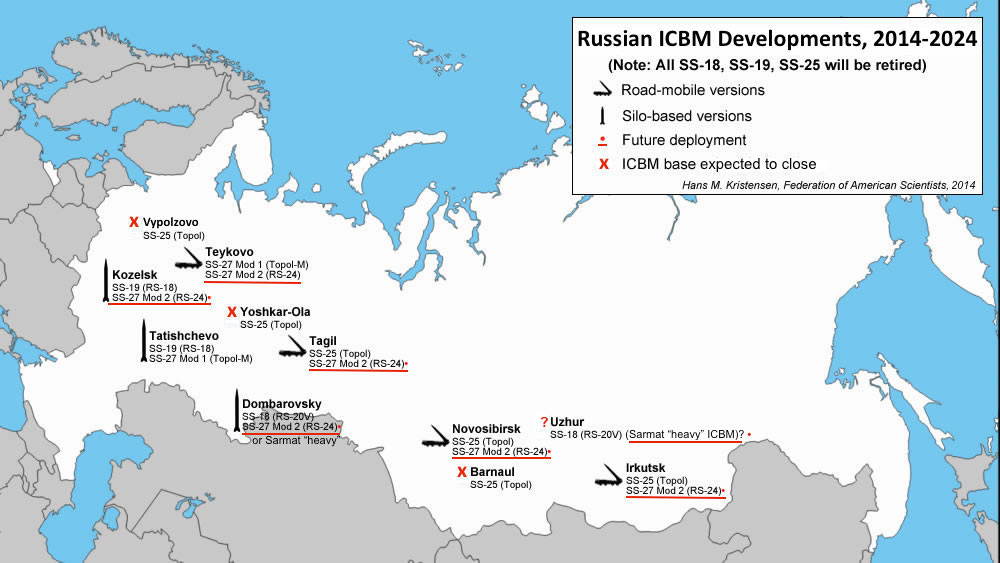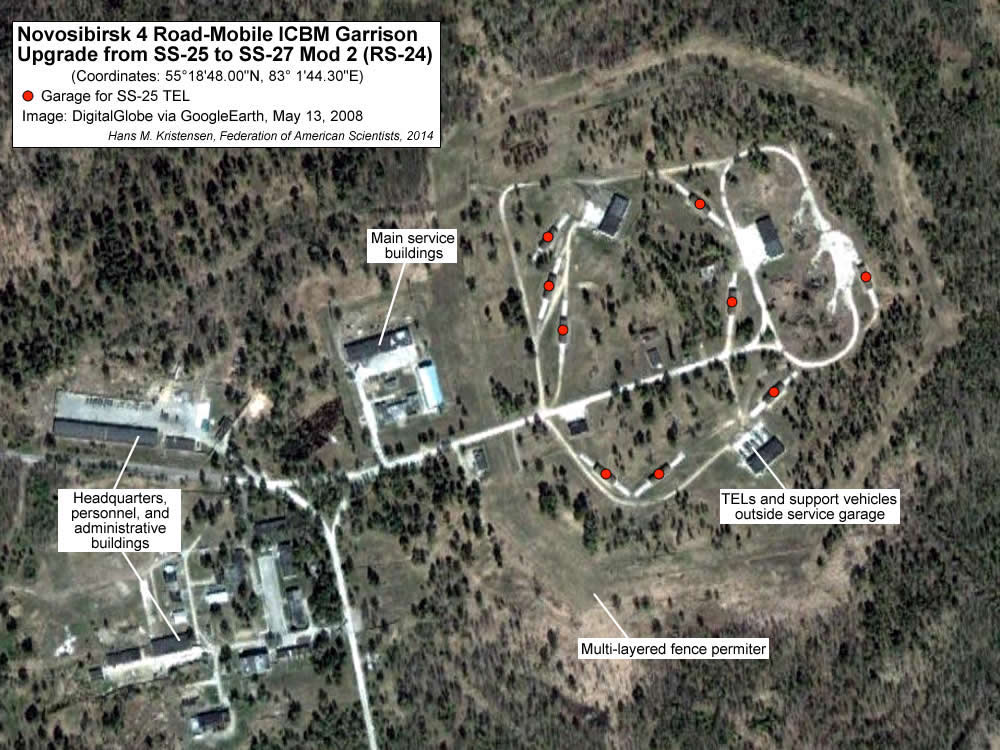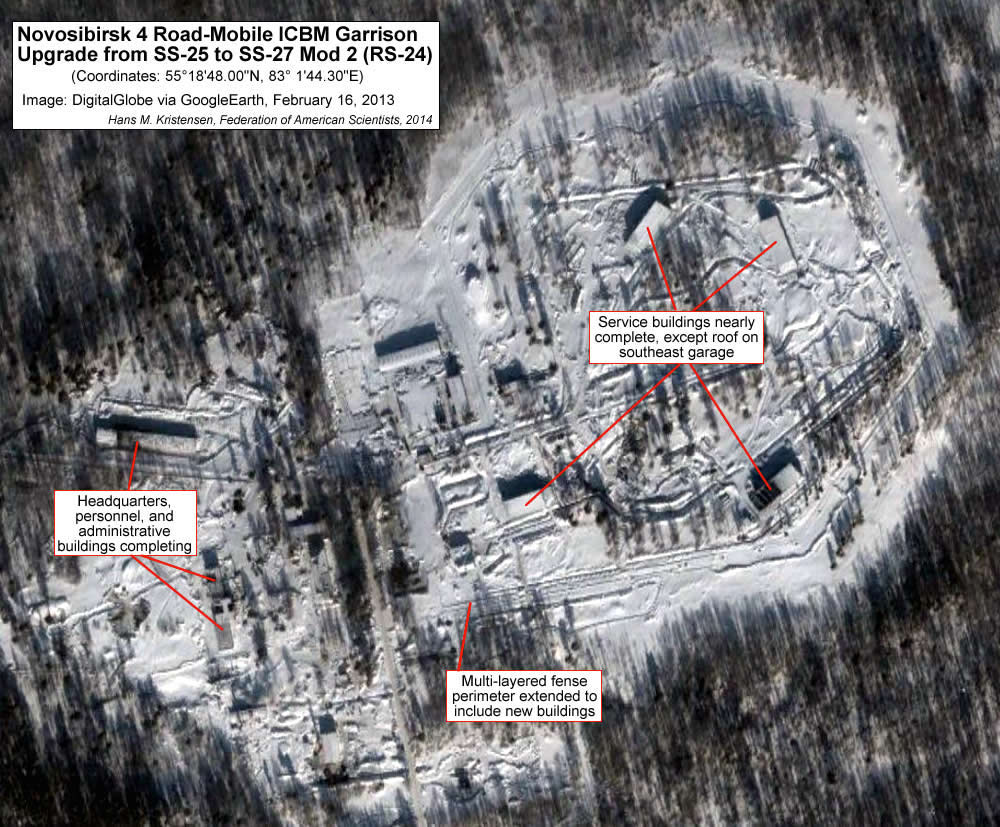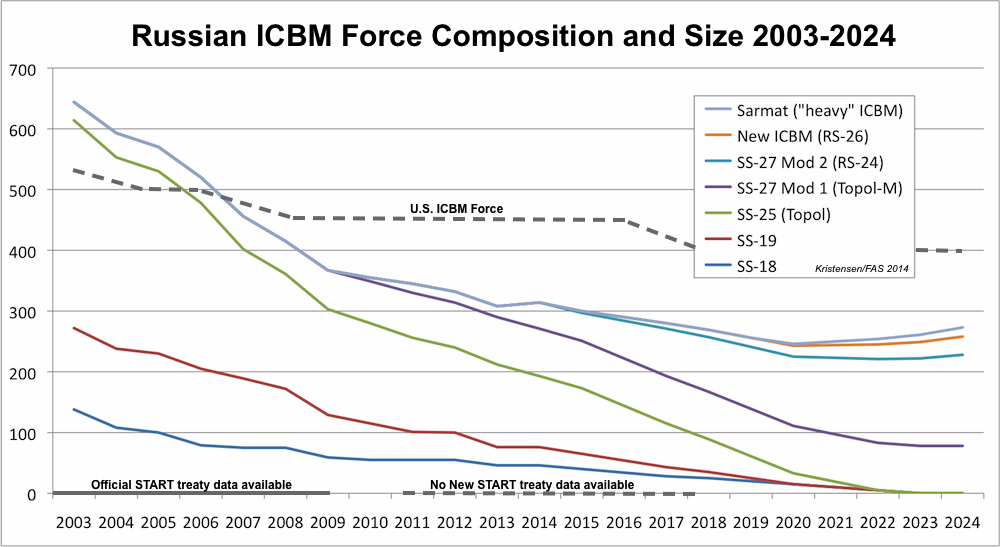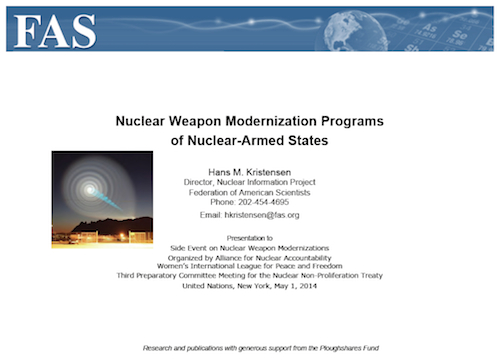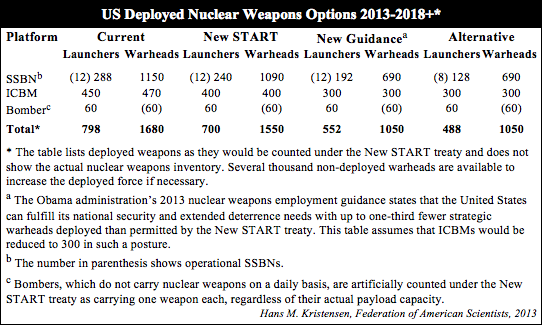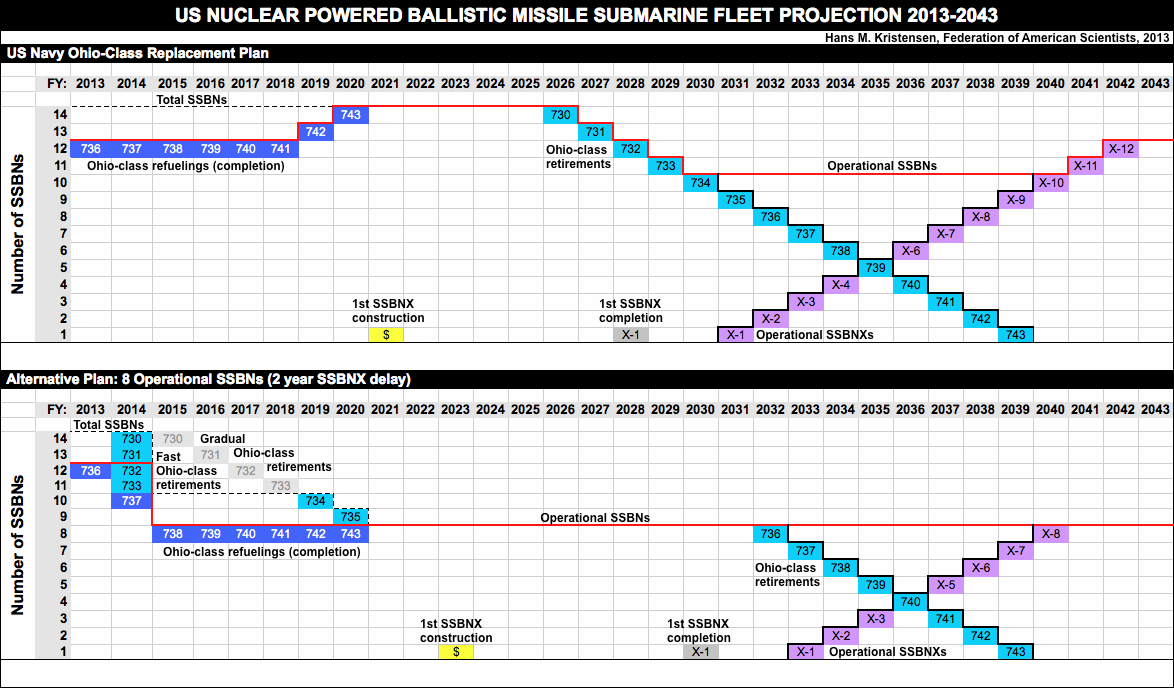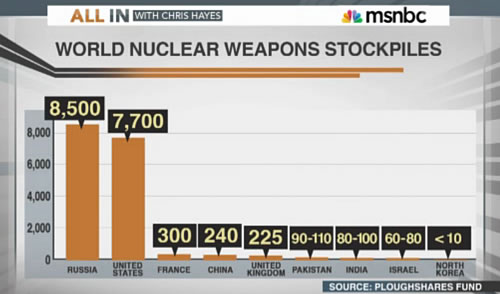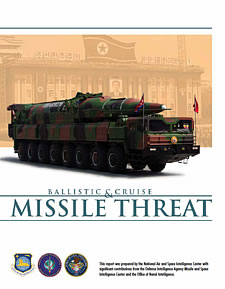Resolving the Crisis in Ukraine: International Crisis Group’s Recommendations
As readers of the FAS Strategic Security Blog know, we have been concerned about the potential of the crisis in Ukraine to escalate, further worsening U.S.-Russian relations and possibly resulting in armed conflict involving NATO and Russia. As the May 25th presidential election in Ukraine is fast approaching, this post draws attention to advice and recommendations from the International Crisis Group, a highly respected non-governmental organization. Here’s the announcement of the major findings from the group’s newest report Ukraine: Running out of Time.
[As an organization comprising thousands of members with differing views, FAS headquarters reminds readers that this and other posts do not represent the position of FAS as an organization. Instead, these posts provide a platform for reasoned discourse and exchange of ideas. Constructive comments are welcomed.]
“Ukraine needs a government of national unity that reaches out to its own people and tackles the country’s long overdue reforms; both Russia and Western powers should back a vision for the country as a bridge between East and West, not a geopolitical battleground.”
The report “offers recommendations to rebuild and reform the country and reverse the geopolitical standoff it has provoked. The Kyiv government has been unable to assert itself or communicate coherently and appears to have lost control of parts of the country to separatists, emboldened if not backed by Russia. To prevent further escalation, Ukraine needs strong international assistance and the commitment of all sides to a solution through dialogue, not force.
The report’s major findings and recommendations are:
- Although conditions for the election are far from ideal, it must take place as planned and nationwide. The vote is needed to produce a new leader with a popular mandate to steer the country through a process of national reconciliation and economic reform. All presidential candidates should, before the polls, commit to establish a broad-based government of national unity; the new president’s first priority must be to form such a government.
- Ukrainian leaders should reach out immediately to the south and east and explain plans for local self-government and minority rights; they should also declare that they do not desire NATO membership.
- Ukraine’s damage goes far beyond separatism. It is the fruit of decades of mismanagement and corruption across security organs and most other arms of government. Far-reaching reform of the security sector and measures to strengthen the rule of law are crucial.
- Russia should declare unqualified support for Ukraine’s territorial integrity and withdraw all troops from the borders, as well as any paramilitaries who have infiltrated from Crimea or elsewhere. It should persuade Russian speakers in the south and east to end their occupations of government buildings and attacks on local security apparatuses and disband their militias.
- The U.S. and EU need to convey a consistent and measured message, recognizing – even if not accepting – Moscow’s take on the crisis’s origins. This message should comprise political support for Kyiv to conduct elections; political, financial and expert support for a national unity government to carry out stabilization measures; measures to make Ukraine viable for investors; further sanctions to bite deeper into Russia’s economy if it does not change course; and quiet high-level talks with Moscow aimed at resolving the crisis.
- Both Moscow and Western powers should emphasize that the present situation can only be resolved by diplomatic means; express support for a post-election government of national unity; take all possible measures to avoid geopolitical confrontation; and insulate other mutual concerns from divisions over Ukraine.
‘On the ground in Ukraine today, Russia has immediate advantages of escalation,’ says Paul Quinn-Judge, Europe and Central Asia Program Director. ‘Over time, the West likely has the economic and soft-power edge. A successful, democratic Ukraine – integrated economically in the West but outside military alliances, and remaining a close cultural, linguistic and trading partner of Russia – would benefit all.’”
Preventing Ukraine From Spiraling Out of Control
The crisis in Ukraine continues to simmer, but thankfully has not yet boiled over. Here are some of the developments since I last wrote on this topic, followed by some thoughts on what is needed to minimize the risk of the conflict spiraling out of control.
Former Ukrainian President Leonid Kuchma assessed the situation as follows:
Russia does not recognize the legitimacy of the current government in Kyiv and will not negotiate with it. Ukraine has no chance there. Ukraine could have taken concrete steps in this direction in the beginning but we didn’t do that. For instance, a delegation of lawmakers could have gone to Moscow [to bring Russia into the process.] …
To analyze Russia’s actions, you have to try to understand Putin’s point of view. Russia has always feared having NATO right under Moscow’s nose. … Putin never trusted Ukraine, especially its government. He always assumed that one day someone would come to power in Ukraine that would ignore the Russian-Ukrainian friendship, and Ukraine would join the European Union and NATO. …
I don’t see any candidate [for the Ukrainian presidency] who enjoys enough popularity to unite Ukraine. …The future leadership should include representatives of all regions in order to unite the country. If it consists of only half of Ukraine, there will consequences in the other half of the country.
Prof. Keith Darden of American University wrote in Foreign Affairs:
A pro-European, pro-NATO government ruling a regionally divided country – and one that is quite vulnerable to Russian military intervention – is a recipe for instability, not for European integration. Simply pushing forward with EU association and NATO integration without pushing the government in Kiev to address its illegitimacy problems through means other than arrest is not much of a strategy. It’s not even much of a gamble, as it is almost certain to fail. One way or another, power in Ukraine needs to be spread out. …
The most obvious way to do that is through some form of constitutional change. Call it what you want: decentralization, federalization, regionalization. … Kiev needs to transfer some very substantial powers, including those over education, language, law, and taxation, to the regions. … The Russian plan to federalize Ukraine, which, in reality, is a plan to turn Ukraine into a weak confederation where the central government is largely ceremonial, is a step too far. … [But] As long as Ukraine retains its highly centralized winner-take-all political system, and one regional faction sits in Kiev with the backing of either Russia or the West, Ukraine is going to be unstable. With a little bit of constitutional accommodation, though, the divided house just might stand.
The interim Ukrainian government (or junta in Moscow’s view) has repeatedly attempted to use military force to evict pro-Russian demonstrators (or terrorists in Kiev’s view) from government buildings in the eastern part of Ukraine. These efforts have had limited success, with some Ukrainian units surrendering or defecting to the pro-Russian side. This may lead (or already have led) Kiev to consider using some of Ukraine’s more virulently anti-Russian elements (e.g., the Pravy (Right) Sektor and the Svoboda Party) since they can be counted on not to avoid bloodshed.
Russia sees the West as exercising a blatant double standard in that it warned Yanukovych not to use military force against the Maidan demonstrators who eventually brought down his government, yet approves the use of similar force against pro-Russian demonstrators. Of course, Russia itself is not immune to holding double standards, but that makes things doubly dangerous. If both sides in a conflict mistakenly believe they are in the right, they then expect the other (“wrong”) side to back down. When both sides have thousands of nuclear weapons, the risk is clearly heightened.
Conditions almost boiled over last Friday (May 2) when pro- and anti-Russian gangs clashed in a bloody riot in Odessa and dozens of pro-Russian demonstrators were burned alive in a fire. According to the New York TImes:
What followed were hours of bloody street clashes involving bats, pistols and firebombs. … The pro-Russians, outnumbered by the Ukrainians, fell back … [and] sought refuge in the trade union building.
Yanus Milteynus, a 42-year-old construction worker and pro-Russian activist, said he watched from the roof as the pro-Ukrainian crowd threw firebombs into the building’s lower windows, while those inside feared being beaten to death by the crowd if they tried to flee. …
The conflict is hardening hearts on both sides. As the building burned, Ukrainian activists sang the Ukrainian national anthem, witnesses on both sides said. They also hurled a new taunt: “Colorado” for the Colorado potato beetle, striped red and black like the pro-Russian ribbons. Those outside chanted “burn Colorado, burn,” witnesses said. Swastikalike symbols were spray painted on the building, along with graffiti reading “Galician SS,” though it was unclear when it had appeared, or who had painted it.
It should be noted that anti-Russian reports allege that the fire was started by the pro-Russian group when they threw Molotov cocktails down from the upper floors. It is impossible at this point in time to say which version is true, and that cautionary note applies to almost all reports.
Harvard’s Prof. Graham Allison summarized the nuclear risk well in a recent article in The National Interest:
The thought that what we are now witnessing in Ukraine could trigger a cascade of actions and reactions that end in war will strike most readers as fanciful. Fortunately, it is. But we should not forget that in May 1914, the possibility that the assassination of an Archduke could produce a world war seemed almost inconceivable. History teaches that unlikely, even unimaginable events do happen.
Given that less than six years elapsed between the Georgian War and this current crisis, each with the potential to lead to armed conflict between US and Russian forces or nuclear threats, even a small probability for each event to escalate can result in an unacceptable cumulative risk.
Adding to the risk, British Foreign Minister William Hague just told Georgia that its bid to join NATO enjoys his “very clear support.” Such promises appear to have played a role both in emboldening Georgia to fire the first shots in its 2008 war with Russia and in Russia’s outsized reaction. While the promise was made to Georgia, it seems clearly linked to the situation in Ukraine.
To reduce the risk of the Ukrainian crisis spiraling out of control, both the West and Russia should stop viewing the conflict as a football game in which there is a winner and a loser. Instead, we need to start being more concerned with creating a situation in which all the people of Ukraine can live reasonable lives, without fear of subjugation or physical harm.
Russian ICBM Force Modernization: Arms Control Please!
By Hans M. Kristensen
In our Nuclear Notebook on Russian nuclear forces from March this year, Robert S. Norris and I described the significant upgrade that’s underway in Russia’s force of land-based intercontinental ballistic missiles (ICBMs).
Over the next decade, all Soviet-era ICBMs will be retired and replaced with a smaller force consisting of mainly five variants of one missile: the SS-27.
After more than a decade-and-a-half of introduction, the number of SS-27s now makes up a third of the ICBM force. By 2016, SS-27s will make up more than half of the force, and by 2024 all the Soviet-era ICBMs will be gone.
The new force will be smaller and carry fewer nuclear warheads than the old, but a greater portion of the remaining warheads will be on missiles carried on mobile launchers.
The big unknowns are just how many SS-27s Russia plans to produce and deploy, and how many new (RS-26 and Sarmat “heavy”) ICBMs will be introduced. Without the new systems or increased production of the old, Russia’s ICBM force would probably level out just below 250 missiles by 2024. In comparison, the U.S. Air Force plans to retain 400 ICBMs.
This disparity and the existence of a large U.S. reserve of extra warheads that can be “uploaded” onto deployed missiles to increase the arsenal if necessary drive top-heavy ICBM planning in the Russian military which seeks to maximize the number of warheads on each missile to compensate for the disparity and keep some degree of overall parity with the United States.
This dilemma suggests the importance of reaching a new agreement to reduce the number deployed strategic warheads and missiles. A reduction of “up to one-third” of the current force, as recently endorsed by the new U.S. nuclear employment strategy, would be a win for both Russia and the United States. It would allow both countries to trim excess nuclear capacity and save billions of dollars in the process.
Phased Deployment
Introduction of the SS-27 has come in two phases. The first phase, which last from 1997 to 2013, involved deployed the single-warhead type (SS-27 Mod 1; Topol-M) in silos and on road-mobile launchers. The silo-based version was deployed first, replacing SS-19s in the 60th Missile Division at the Tatishchevo missile field outside Saratov. The deployment was completed in 2013 (see picture below) after 60 SS-27 Mod 1 missiles had been lowered into former SS-19 silos at a slow pace of less than 4 missile in average per year.

An SS-27 Mod 1 (Topol-M) is lowered into a former SS-19 silo at the Tatishchevo missile field outside Saratov.
In 2006, deployment of the first road-mobile SS-27 Mod 1 began with the 54th Guards Missile Division at Teykovo northeast of Moscow. The deployment was completed in 2010 with 18 missiles in two regiments.
With completion of the SS-27 Mod 1 deployment of 78 missiles, efforts have since shifted to deployment of a MIRVed version of the SS-27, known as SS-27 Mod 2, or RS-24 Yars in Russia. It is essentially the same missile as the Mod 1 version except the payload “bus” has been modified to carry multiple independently targetable warheads (MIRV). Each missile is thought to be able to carry up to 4 warheads, although there is uncertainty about what the maximum capacity is (but it is not 10 warheads, as often claimed in Russian news media).
The first road-mobile SS-27 Mod 2s were deployed at Teykovo in 2010, alongside the SS-27 Mod 1s already deployed there. For the foreseeable future, all new Russian ICBM deployments will be of MIRVed versions of the SS-27, although a “new ICBM” and a “heavy ICBM” are also being developed.
In 2012, preparations began for introduction of SS-27 Mod 2 at three additional missile divisions. At the 28th Missile Guards Division at Kozelsk southwest of Moscow, conversion of former SS-19 silos (see picture below) to carry the SS-27 Mod 2 is underway with deployed of the first regiment (10 missiles) scheduled this year. How many missiles will be deployed at Kozelsk is unclear. The missile field originally included 60 SS-19 silos but half have been demolished so perhaps the plan is for three regiments with 30 SS-27 Mod 2 missiles. After silo-based RS-24s are installed at Kozelsk, deployment will follow at the 13th Missile Division at Dombarovsky, replacing the SS-18s currently deployed there.
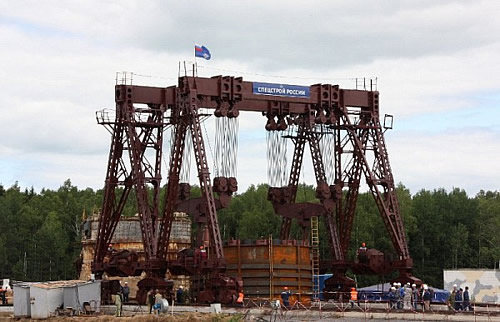
A former SS-19 ICBM silo at Kozelsk is being upgraded to receive the SS-27 Mod 2 (RS-24 Yars) ICBM. Deployment begins this year.
In addition to Kozelsk, preparations are also underway to upgrade three road-mobile SS-25 garrisons to the SS-27 Mod 2. At this point, this includes the 51st Missile Guards Division at Irkutsk, the 39th Guards Missile Division at Novosibirsk, and the 42nd Missile Division at Nizhniy Tagil.
Preparation started at Novosibirsk in 2012, where two of four garrisons are under conversion. One of these (Novosibirsk 4; see further description below) is nearly complete. Conversion started at Irkutsk in 2012 with dismantling of SS-25 garages at one of the three remaining garrisons. At Tagil, SS-27 Mod 2 introduction is underway at two of three remaining SS-25 garrisons. In December 2013, the first SS-27 Mod 2 regiment at Novosibirsk (9 launchers) and one partially equipped (6 launchers) regiment at Tagil were put on “experimental combat duty.”
The remaining SS-25 divisions – the 7th Guards Missile Division at Vypolsovo, the 14th Missile Division at Yoshkar-Ola, and the 35th Missile Division at Barnaul – have not been mentioned for SS-27 Mod 2 upgrade and seem destined for retirement. One of the three garrisons at Yoshkar-Ola has been inactivated.
Below follows a more detailed description of the upgrade to SS-27 Mod 2 (RS-24) underway at Novosibirsk.
SS-27 Upgrade at Novosibirsk
As mentioned above, the 39th Guards Missile Division at Novosibirsk is being upgraded from the solid-fuel road-mobile single-warhead SS-25 ICBM to the solid-fuel road-mobile MIRVed SS-27 Mod 2 (RS-24). A series of unique satellite images provided by Digital Globe to Google Earth show the upgrade of one of four garrisons (Novosibirsk 4) between 2008 and 2013.
The first image from May 2008 (see below) shows the garrison with all nine garages for SS-25 road-mobile launchers (TELs) clearly visible inside the multi-layered fence perimeter. Several TELs and support vehicles are parked outside one of three service buildings.
The second image from June 2012 (see below) shows that all nine TEL garages have been dismantled and the roof is missing on the three service vehicle buildings. Two new service buildings are under construction just outside the fence perimeter and several buildings have been demolished in preparation for new administrative and technical buildings.
The third image, taken in February 2013, shows the fence perimeter at the southwest corner of the garrison has been extended westward to include the new service buildings. This extension is similar to the change that was made at Teykovo when two garrisons were equipped with the SS-27 Mod 2 (RS-24). The image indicates that support vehicle garages inside the fence perimeter are almost done, and that administrative and technical buildings outside the perimeter have been added.
The fourth image (see below), from September 2013, shows installation of new TEL garages for the SS-27 Mod 2 (RS-24) launchers well underway, with seven of eventually nine garages visible. The green roofs of the four large service vehicle garages are clearly visible, as are the new administrative and technical building outside the fence perimeter.
The Future ICBM Force
Predicting the size and composition of the Russian ICBM force structure into the future comes with a fair amount of uncertainty because Russia doesn’t release official data on its nuclear forces, because U.S. intelligence agencies no longer publish detailed information on Russian nuclear forces, and because Russian aggregate data under the New START treaty is not made public (unlike during the previous START treaty). Nonetheless, based on previous history, scattered officials statements, and news media reports, it is possible to make a rough projection of how the Russian ICBM might evolve over the next decade (see graph below).
This shows that the size of the Russian ICBM force dropped below the size of the U.S. ICBM force in 2007 mainly due to the rapid reduction of the SS-25 ICBM. By the early 2020s, according to recent announcements by Russian military officials, all SS-18, SS-19, and SS-25 ICBMs will be gone. Development of a new ICBM – apparently yet another version of the SS-27 – known in Russia as the RS-26 is underway for possible introduction in 2015. And a new liquid-fuel “heavy” ICBM known in Russia as the Sarmat, and nicknamed “Son of Satan” because it apparently is intended as a replacement for the SS-18 (which was code-named Satan by the United States and NATO) is said to be scheduled for introduction around 2020.
This development would leave a Russian ICBM force structure based on five modifications of the solid-fuel SS-27 (silo- and mobile-based SS-27 Mod 1; silo- and mobile-based SS-27 Mod 2 (RS-24); and the RS-26) and the liquid-fuel Sarmat with a large payload – either MIRV or some advanced payload to evade missile defense systems. Although the future force will be smaller, a greater portion of it will be MIRVed – up from approximately 36 percent today to roughly 70 percent by 2024. This increasingly top-heavy ICBM force is bad for U.S-Russian strategic stability.
I hope I’m mistaken about the possible increase in the Russian ICBM force after 2020. In fact, it seems more likely that the Russian economy will not be able to support the production and deployment of “over 400 modern land and sea-based inter-continental ballistic missiles” that President Putin promised in 2012. But if I’m not mistaken, then it would be an immensely important development. Not that I think it would matter that much militarily in the foreseeable future or necessarily signal a new arms race. But it would be a significant break with the trend we have seen in Russian nuclear forces since the end of the Cold War, and it would create serious problems for the stability of the Non-Proliferation Treaty regime. It is important that the Russian government provides more transparency about its nuclear force structure plans and demonstrate that it is not planning to increase its ICBM force shortly after the New START treaty expires in 2018.
Regardless, there is an increasing need for Russia and the United States to make more progress on nuclear arms control. Notwithstanding its important verification regime, the New START treaty was too modest to impress anyone (it has no real effect on Russian nuclear forces and it is so modest that the United States plans to keep emptied ICBM silos instead of destroying them). A good start would be a new arms control agreement with “up to one-third” fewer deployed strategic warheads and launchers than permitted by the New START Treaty, as recently endorsed by the U.S. Nuclear Employment Strategy. Such an agreement would force Russia to reduce the warhead loading on its ICBMs and force the United States to reduce its large ICBM force.
It is also important that the United States and Russia revisit the MIRV-ban. The START II treaty, which was signed but not ratified and later abandoned by Vladimir Putin and George W. Bush in 2002, included a ban on MIRVed ICBMs. Apart from reducing the warheads the two nuclear superpowers would be able to launch agains each other, a MIRV ban would also serve the vital role of discouraging other nuclear-armed states from deploying multiple warheads on their ballistic missiles in the future, which could otherwise significantly increase their nuclear arsenals and result in regional arms races.
Trying to pursue new reductions in excessive and expensive nuclear forces and avoid counterproductive modernization programs is perhaps even more important now given the souring relations caused by the crisis in Ukraine. Don’t forget: even at the height of the Cold War it was possible – in fact essential – to reach nuclear arms control agreements.
Additional background: Russian Nuclear Forces, 2014 | Russian SSBN Fleet
This publication was made possible by a grant from the Ploughshares Fund. The statements made and views expressed are solely the responsibility of the author.
Nuclear Modernization Briefings at the NPT Conference in New York

By Hans M. Kristensen
Last week I was in New York to brief two panels at the Third Session of the Preparatory Committee for the 2015 Review Conference of the Parties to the Treaty on the Non-Proliferation of Nuclear Weapons (phew).
The first panel was on “Current Status of Rebuilding and Modernizing the United States Warheads and Nuclear Weapons Complex,” an NGO side event organized on May 1st by the Alliance for Nuclear Accountability and the Women’s International League for Peace and Freedom (WILPF). While describing the U.S. programs, I got permission from the organizers to cover the modernization programs of all the nuclear-armed states. Quite a mouthful but it puts the U.S. efforts better in context and shows that nuclear weapon modernization is global challenge for the NPT.
The second panel was on “The Future of the B61: Perspectives From the United States and Europe.” This GNO side event was organized by the Nuclear Age Peace Foundation on May 2nd. In my briefing I focused on providing factual information about the status and details of the B61 life-extension program, which more than a simple life-extension will produce the first guided, standoff nuclear bomb in the U.S. inventory, and significantly enhance NATO’s nuclear posture in Europe.
The two NGO side events were two of dozens organized by NGOs, in addition to the more official side events organized by governments and international organizations.
The 2014 PREPCOM is also the event where the United States last week disclosed that the U.S. nuclear weapons stockpile has only shrunk by 309 warheads since 2009, far less than what many people had anticipated given Barack Obama’s speeches about “dramatic” and “bold” reductions and promises to “put an end to Cold War thinking.”
Yet in disclosing the size and history of its nuclear weapons stockpile and how many nuclear warheads have been dismantled each year, the United States has done something that no other nuclear-armed state has ever done, but all of them should do. Without such transparency, modernizations create mistrust, rumors, exaggerations, and worst-case planning that fuel larger-than-necessary defense spending and undermine everyone’s security.
For the 185 non-nuclear weapon states that have signed on to the NPT and renounced nuclear weapons in return of the promise made by the five nuclear-weapons states party to the treaty (China, France, Russia, United Kingdom, and the United States) “to pursue negotiations in good faith on effective measures relating to the cessation of the nuclear arms race at early date and to nuclear disarmament,” endless modernization of the nuclear forces by those same five nuclear weapons-states obviously calls into question their intension to fulfill the promise they made 45 years ago. Some of the nuclear modernizations underway are officially described as intended to operate into the 2080s – further into the future than the NPT and the nuclear era have lasted so far.
Download two briefings listed above: briefing 1 | briefing 2
This publication was made possible by a grant from the Ploughshares Fund. The statements made and views expressed are solely the responsibility of the author.
Obama Administration Decision Weakens New START Implementation
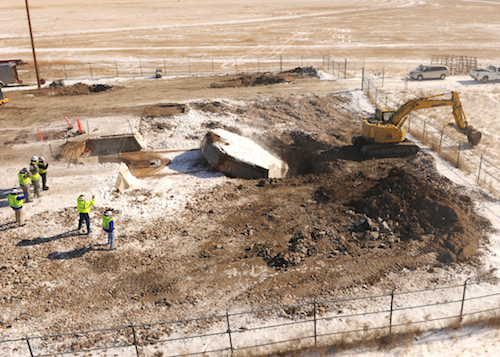
At the same time the Air Force is destroying 50 silos at Malmstrom AFB (above) and another 50 at F.E Warren AFB emptied by the Bush administration, the Obama administration has decided to retain 50 silos scheduled to be emptied under the New START treaty.
By Hans M. Kristensen
After four years of internal deliberations, the U.S. Air Force has decided to empty 50 Minuteman III ICBMs from 50 of the nation’s 450 ICBM silos. Instead of destroying the empty silos, however, they will be kept “warm” to allow reloading the missiles in the future if necessary.
The decision to retain the silos rather than destroy them is in sharp contrast to the destruction of 100 empty silos currently underway at Malmstrom AFB and F.E. Warren AFB. Those silos were emptied of Minuteman and MX ICBMs in 2005-2008 by the Bush administration and are scheduled to be destroyed by 2016.
A New Development
The Obama administration’s decision to retain the silos 50 silos “reduced” under the New START treaty instead of destroying them is a disappointing new development that threatens to weaken New START treaty implementation and the administration’s arms reduction profile. And it appears to be a new development.
A chart in a DOD’s unclassified report to Congress shows that the plan to retain the 50 non-operational ICBM launchers is different than the treaty implementation efforts so far, which have been designed to “eliminate” non-operational launchers.

The plan to retain non-deployed ICBM launchers is different than other aspects of the U.S. New START implementation plan
Indeed, a senior defense official told the Associated Press that the Pentagon had never before structured its ICBM force with a substantial number of missiles in standby status.
Reducing Force Structure Flexibility
The decision to retain the 50 empty silos is also puzzling because it reduces U.S. flexibility to maintain the remaining nuclear forces under the New START limit. The treaty stipulates that the United States and Russia each can only have 700 deployed launchers and 100 non-deployed launchers. But the 50 empty silos will count against the total limit, essentially eating up half of the 100 non-deployed launcher limit and reducing the number of spaces available for missiles and bombers in overhaul.
If, for example, two SSBNs (with 40 missiles), two ICBMs, and eight bombers were undergoing maintenance at the same time, no additional launchers could be removed from deployed status for maintenance unless the deployed force was reduced below 700 launchers. This is not inconceivable. In September 2013, for example, 76 SLBM launchers and 21 B-2A/B-52H bombers (a total of 97 launchers) were counted as non-deployed.
Why the administration would accept such constraints on the flexibility of the U.S. nuclear force posture simply to satisfy the demands of the so-called ICBM caucus in Congress is baffling.
The Reductions
With the DOD New START force structure decision, the future force is now set. The DOD report includes the table below (note: a column with the 2014 deployed launchers has been added to improve comparison), which is also reproduced in a fact sheet (with some corrections and additional information about bombers):
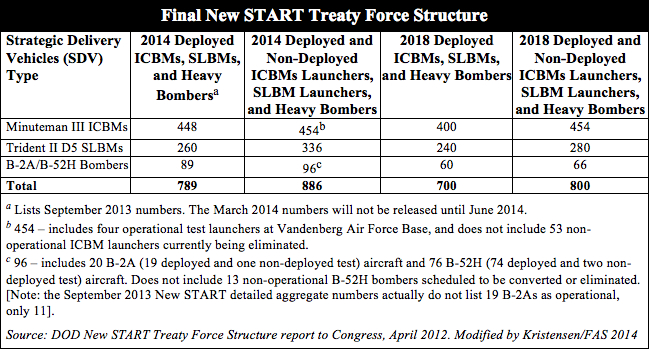
Other than the decision to retain, rather than dismantle, the excess 50 ICBM silos, there are no real surprises. The reductions in actual nuclear forces are very modest. Moreover, the June 2013 Nuclear Weapons Employment Strategy of the United States, which is intended to look beyond 2018, ordered no additional force structure reductions below the New START limits, yet determined that the United States could meet its national and international obligations with up to one-third fewer deployed weapons (1,100 warheads on 470 launchers).
Strategic Implications
What would be the scenario in which the United States would have to redeploy missiles in the extra 50 “warm” silos that the administration has decided to retain? Notwithstanding the crisis in Ukraine, it is hard to envision one.

The 50 Minuteman III missiles from the silos will be stored at Hill Air Force Base for potential reloading into the “warm” silos or eventually to be used as flight test assets. What scenario would necessitate redeploying the missiles?
Image credit: @Paul Shambroom/Institute
Unlike the United States, Russia is already well below the New START limit and currently has about 140 ICBMs in silos and another 170 on mobile launchers for a total force of a little over 300 missiles. Despite Russian deployment of new missiles, this ICBM force is likely to drop well below 300 by the early 2020s.
Moreover, the Pentagon determined in 2012 that Russia “would not be able to achieve a militarily significant advantage by any plausible expansion of its strategic nuclear forces, even in a cheating or breakout scenario under the New START Treaty” (emphasis added).
To compensate for the ICBM launcher imbalance and maintain some degree of overall parity with the U.S. arsenal, Russia is deploying more warheads on each of its ICBMs.
This top-heavy posture is bad for strategic stability. It is in the U.S. national security interest to reduce this disparity to increase strategic stability between the world’s two largest nuclear powers. The decision to retain excess ICBM silos instead of destroying them contributes to a Russian misperception that the United States is intent on retaining a strategic advantage and a breakout capability from the New START treaty to quickly increase its deployed nuclear forces if necessary.
The administration can and should change its decision and destroy the ICBM silos that are emptied under New START.
This publication was made possible by a grant from the Ploughshares Fund. The statements made and views expressed are solely the responsibility of the author.
New START Data Show Russian Increase, US Decrease Of Deployed Warheads
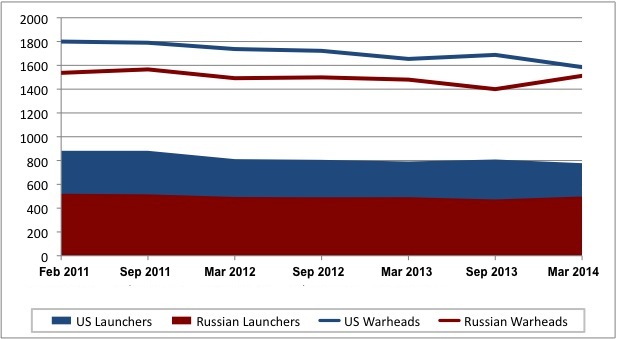
By Hans M. Kristensen
The latest aggregate data released by the US State Department for the New START treaty show that Russia has increased its counted deployed strategic nuclear forces over the past six months.
The data show that Russia increased its deployed launchers by 25 from 473 to 498, and the warheads attributed to those launchers increased by 112 from 1,400 to 1,512 compared with the previous count in September 2013.
During the same period, the United States decreased its number of deployed launchers by 31 from 809 to 778, and the warheads attributed to those launchers decreased by 103 from 1,688 to 1,585.
The increase of the Russian count does not indicate that its in increasing its strategic nuclear forces but reflects fluctuations in the number of launchers and their attributed warheads at the time of the count. At the time of the previous data release in September 2013, the United States appeared to have increased its forces. But that was also an anomaly reflecting temporary fluctuations in the deployed force.
Both countries are slowly reducing their strategic nuclear weapons to meet the New START treaty limit by 2018 of no more than 1,550 strategic warheads on 700 deployed launchers. Russia has been below the treaty warhead limit since 2012 and was below the launcher limit even before the treaty was signed. The United States has yet to reduce below the treaty limit.
Since the treaty was signed in 2010, the United States has reduced its counted strategic forces by 104 deployed launchers and 215 warheads; Russia has reduced its counted force by 23 launchers and 25 warheads. The reductions are modest compared with the two countries total inventories of nuclear warheads: Approximately 4,650 stockpiled warheads for the United States (with another 2,700 awaiting dismantlement) and 4,300 stockpiled warheads for Russia (with another 3,500 awaiting dismantlement).
Details of the Russian increase and US decrease are yet unclear because neither country reveals the details of the changes at the time of the release of the aggregate data. In about six months, the United States will publish a declassified overview of its forces; Russia does not publish a detailed overview of its strategic forces.
For analysis of the previous New START data, see: /blogs/security/2013/10/newstartsep2013/
Detailed nuclear force overviews are available here: Russia | United States
This publication was made possible by a grant from the Ploughshares Fund. The statements made and views expressed are solely the responsibility of the author.
Ukraine: The Value of Risk Analysis in Foreseeing Crises
The quantitative risk analysis approach to nuclear deterrence not only allows a more objective estimate of how much risk we face, but also highlights otherwise unforeseen ways to reduce that risk. The current crisis in Ukraine provides a good example.
Last Fall, I met Daniel Altman, a Ph.D. candidate at MIT, who is visiting Stanford’s Center for International Security and Cooperation (CISAC) this academic year. When I told him of my interest in risk analysis of nuclear deterrence, he said that I should pay attention to what might happen in Sevastopol in 2017, something that had been totally off my radar screen.
Sevastopol is home to Russia’s Black Sea Fleet, and along with the rest of the Crimea, was part of Russia until 1954, when Khrushchev arbitrarily “gave” it to the Ukraine. With Russia and Ukraine both parts of the Soviet Union, such a transfer of territory seemed to make no real difference. But, when the USSR broke up in 1991, a good case can be made that the Crimea, with its largely Russian population, should have been returned to Russia.
That did not happen, and with Sevastopol now part of an independent Ukraine, Russia had to negotiate a lease on what, for centuries, had been its own naval base. That lease runs out in 2017. Back in 2008, when she was Prime Minister of a somewhat Russo-phobic Ukrainian government, Yulia Tymoshenko ruled out any extension of the lease. If that were to happen, the ethnic Russians in the Crimea, and especially those in Sevastopol – many of whom depend on the Black Sea Fleet for employment – would likely petition to be reincorporated back into Russia. This would be likely to create an extremely dangerous crisis, since Russia would see this as righting an historical mistake, while the West would see it as Russia stealing part of the Ukraine.
The potential for such a crisis was reduced in 2010, when the more Russian-friendly government of Ukrainian President Viktor Yanukovych extended the lease on Sevastopol for 25 years. But even before the current crisis, there was a risk that a new, Russo-phobic government could come to power and annul the lease extension. Now that Yanukovych has been deposed and anti-Russian Ukrainian elements are part of the interim government, that is an even greater concern.
Given Altman’s alerting me to the risk of “Sevastopol 2017,” I was less surprised, but more concerned than most Americans when the current crisis developed in Ukraine. My concern escalated yesterday (Saturday, March 1, 2014) when Putin requested and received authorization “in connection with the extraordinary situation that has developed in Ukraine … to use the Armed Forces of the Russian Federation on the territory of Ukraine until the social and political situation in that country is normalised.” The resultant actions by Russian troops are seen as an invasion by some elements of the interim Ukrainian government.
Ronald Reagan’s former ambassador to Moscow, Jack Matlock, has a more nuanced take on the situation, starting with a February 8 article which argues that whichever side (Russia or the EU) wins the economic tug of war over Ukraine would lose:
So what if President Yanukovych had signed the EC association agreement? The money available from the IMF would not have staved off bankruptcy very long and would have required unpopular austerity measures … The upshot would be that, most likely, in a year to 18 months, and maybe even sooner, most Ukrainians would blame the EU and the West for their misery.
And if the Russian promise of a loan and cheap gas is renewed to some Ukrainian government, that too would do nothing to promote the reform and modernization the Ukrainian government and economy desperately need. … Ukrainians, even those in the East, would begin to blame Russia for their misery. “If only we had signed that EU association agreement…!”
In sum, I believe it has been a very big strategic mistake – by Russia, by the EU and most of all by the U.S. – to convert Ukrainian political and economic reform into an East-West struggle. … In both the short and long run only an approach that does not appear to threaten Russia is going to work.
Ambassador Matlock posted another article yesterday (Saturday, March 1), which elaborated (emphasis added):
If I were Ukrainian I would echo the immortal words of the late Walt Kelly’s Pogo: “We have met the enemy and he is us.” The fact is, Ukraine is a state but not yet a nation. … The current territory of the Ukrainian state was assembled, not by Ukrainians themselves but by outsiders … To think of it as a traditional or primordial whole is absurd.
… there is no way Ukraine will ever be a prosperous, healthy, or united country unless it has a friendly (or, at the very least, non-antagonistic) relationship with Russia [yet that is the kind of government the West seems intent on installing.] …
So far, Ukrainian nationalists in the west have been willing to concede none of these conditions [needed for stability], and the United States has, by its policies, either encouraged or condoned attitudes and policies that have made them anathema to Moscow. …
Obama’s “warning” to Putin was ill-advised. Whatever slim hope that Moscow might avoid overt military intervention in Ukraine disappeared when Obama in effect threw down a gauntlet and challenged him. This was not just a mistake of political judgment—it was a failure to understand human psychology—unless, of course, he actually wanted a Russian intervention, which is hard for me to believe. …
Ukraine is already shattered de facto, with different groups in command of the various provinces. If there is any hope of putting it together again, there must be cooperation of all parties in forming a coalition at least minimally acceptable to Russia and the Russian-speaking Ukrainian citizens in the East and South.
Ambassador Matlock added another post today (Sunday, March 2) which is also well worth reading, and I’ll end with a few additional thoughts of my own:
Last October and again last November, I quoted Russian international relations expert, Fyodor Lukyanov, as warning that America’s penchant for regime change “will lead to such destabilization that will overwhelm all, including Russia.”
It’s hard for most Americans to see how our helping to overthrow regimes in Iraq, Libya, and the Arab world could produce fears that we also are bent on regime change in a nation as powerful as Russia. But what’s happening in Ukraine brings that fear into sharper focus.
As corrupt and unpopular as Yanukovych was, he was the elected president, and the current interim government can be viewed as the result of mob rule. It doesn’t take 51% of a population to overthrow a government, and some of the groups which overthrew Yanukovych appear to have anti-Russian, anti-Semitic, and possibly even Fascist elements.
It does not seem unreasonable to me for Putin to fear that, if an economic or other crisis were to produce large-scale protests against him, the US would again support regime change. How would we have responded if the Soviet Union had sent support to the Watts rioters in 1965?
It also needs to be recognized that, while Russia’s interests in Ukraine are primarily geopolitical, it also has some legitimate human rights concerns. Under the earlier Ukrainian government, Russian language films imported into Ukraine had to be dubbed into Ukrainian and subtitles added for ethnic Russians. To understand how this felt to them, imagine how we would feel if we were barred by law from watching Hollywood movies in their original English language versions, and instead forced to watch them dubbed into French, with English subtitles.
There is a danger of Russia subjugating Ukraine, but there also is a history of Ukraine subjugating its own Russian minority. A solution is needed which recognizes the legitimate rights of all residents of Ukraine, and right now my nation is not supporting that approach. I hope it will recognize and correct its mistake. That would shorten the suffering of Ukrainian residents of all ethnicities and reduce the risk of a Russian-American crisis – as well as its attendant nuclear risk.
A Credible Radioactive Threat to the Sochi Olympics?
With the Sochi Olympics set to start on February 6th there has been an escalating concern about security threats to the Games. There are hunts for female suicide bombers (“black widows”), video threats from militant groups, etc., all of which have triggered a massive Russian security response, including statements by President Putin insuring the safety of the Games.
Many of the security concerns are raised by the proximity of Sochi to Chechnya and relate to the threats expressed by Chechen leader Doku Umarov who exhorted Islamic militants to disrupt the Olympics.
In the past weeks the region has seen Islamic militants claims that they carried out two recent suicide bombings in Volgorad which tragically killed 34 people and injured scores of others. Volgograd is about 425 miles from Sochi and although the media stresses the proximity it is a considerable distance.
Making the Cut: Reducing the SSBN Force
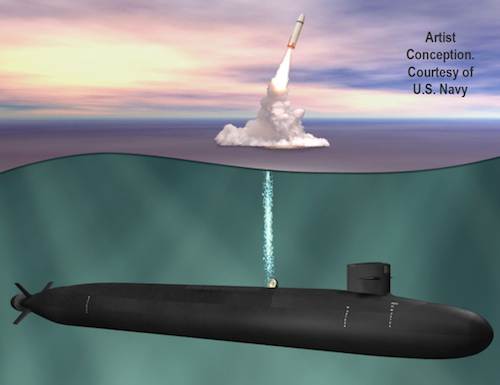
The Navy plans to buy 12 SSBNs, more than it needs or can afford.
By Hans M. Kristensen
A new Congressional Budget Office (CBO) report – Options For Reducing the Deficit: 2014-2023 – proposes reducing the Navy’s fleet of Ohio-class ballistic missile submarines from the 14 boats today to 8 in 2020. That would save $11 billion in 2015-2023, and another $30 billion during the 2030s from buying four fewer Ohio replacement submarines.
The Navy has already drawn its line in the sand, insisting that the current force level of 14 SSBNs is needed until 2026 and that the next-generation SSBN class must include 12 boats.
But the Navy can’t afford that, nor can the United States, and the Obama administration’s new nuclear weapons employment guidance – issued with STRATCOM’s blessing – indicates that the United States could, in fact, reduce the SSBN fleet to eight boats. Here is how.
New START Treaty Force Level
Under the New START treaty the United States plans to deploy 640 ballistic missiles loaded with 1490 warheads (1,550 warheads minus the 60 weapons artificially attributed to bombers that don’t carry nuclear weapons on a daily basis). Of that, the SSBN fleet will account for 240 missiles and 1090 warheads (see table below).
The analysis for the new guidance – formally known as Presidential Policy Decision 24 – determined that the United State could safely reduce its deployed nuclear weapons by up to one-third below the New START level. But even though the current posture therefore is bloated and significantly in excess of what’s needed to ensure the security of the United States and its allies and partners, the military plans to retain the New START force structure until Russia agrees to the reductions in a new treaty.
Yet Russia is already well below the New START treaty force level (-227 launchers and -150 warheads); the United States currently deploys 336 launchers more than Russia (!). Moreover, the Russian missile force is expected to decline even further from 428 to around 400 missiles by the early 2020s – even without a new treaty. Unlike U.S. missiles, however, the Russian missiles don’t have extra warhead spaces; they’re loaded to capacity to keep some degree of treaty parity with the United States.
Making The Cut
The table above includes two future force structure options: a New Guidance option based on the “up to one-third” cut in deployed strategic forces recommended by the Obama administration’s new nuclear weapons employment guidance; and an “Alternative” posture reduced to eight SSBNs as proposed by CBO.
Under the New Guidance posture, the SSBN fleet would carry 690 warheads, a reduction of 400 warheads below what’s planned under the New START treaty. The 192 SLBMs (assuming 16 per next-generation SSBN) would have nearly 850 extra warhead spaces (upload capacity), more than enough to increase the deployed warhead level back to today’s posture if necessary, and more than enough to hedge against a hypothetical failure of the entire ICBM force. In fact, the New Guidance posture would enable the SSBN force to carry almost all the warheads allowed under the New START treaty.
Under the Alternative posture, the SSBN fleet would also carry 690 warheads but there would be 64 fewer SLBMs. Those SLBMs would have “only” 334 extra warhead spaces, but still enough to hedge against a hypothetical failure of the ICBM force. In fact, the SLBMs would have enough capacity to carry almost the entire deployed warhead level recommended by the new employment guidance.
The Navy’s SSBN force structure plan will begin retiring the Ohio-class SSBNs in 2026 at a rate of one per year until the last boat is retired in 2039. The first next-generation ballistic missile submarine (currently known as SSBNX) is scheduled to begin construction in 2021, be completed in 2028, and sail on its first deterrent patrol in 2031. Additional SSBNXs will be added at a rate of one boat per year until the fleet reaches 12 by 2042 (see figure below).
The Navy’s schedule creates three fluctuations in the SSBN fleet. The first occurs in 2019-2020 where the number of operational SSBNs will increase from 12 to 14 as a result of the two newest boats (USS Wyoming (SSBN-742) and USS Louisiana (SSBN-743)) completing their mid-life reactor refueling overhauls. That is in excess of national security needs so at that time the Navy will probably retire the two oldest boats (USS Henry M. Jackson (SSBN-730) and USS Alabama (SSBN-731)) eight years early to keep the fleet at 12 operational SSBNs (this doesn’t show in the Navy’s plan).
The second fluctuation in the Navy’s schedule occurs in 2027-2030 when the number of operational SSBNs will drop to 10 as a result of the retirement of the first four Ohio-class SSBNs and the decision in 2012 to delay the first SSBNX by two years. As it turns out, that doesn’t matter because no more than 10 SSBNs are normally deployed anyway.
The third fluctuation in the Navy’s schedule occurs in 2041-2042 when the number of operational SSBNXs increases from 10 to 12 as the last two boats join the fleet. This is an odd development because there obviously is no reason to increase the fleet to 12 SSBNXs in the 2040s if the Navy has been doing just fine with 10 boats in the 2030s. This also suggests that the fleet could in fact be reduced to 12 boats today of which 10 would be operational. To do that the Navy could retire two SSBNs immediately and two more in 2019-2020 when the last refueling overhauls have are completed.
To reduce the SSBN fleet to eight boats as proposed by CBO, the Navy would retire the six oldest Ohio-class SSBNs at a rate of one per year in 2015-2020. At that point the last Ohio-class reactor refueling will have been completed, making all remaining SSBNs operationally available. A quicker schedule would be to retire four SSBNs in 2014 and the next two in 2019-2020. That would bring the fleet to eight operational boats immediately instead of over seven years and allow procurement of the first SSBNX to be delayed another two years (see figure above).
Reducing to eight SSBNs would obviously necessitate changes in the operations of the SSBN force. The Navy’s 12 operational SSBNs conduct 28 deterrent patrols per year, or an average of 2.3 patrols per submarine. The annual number of patrols has decline significantly over the past decade, indicating that the Navy is operating more SSBNs than it needs. Each patrol lasts on average 70 days and occasionally over 100 days. To retain the current patrol level with only eight SSBNs, each boat would have to conduct 3.5 patrols per year. Between 1988 and 2005, each SSBN did conduct that many patrols per year, so it is technically possible.
Moreover, of the 10 or so SSBNs that are at sea at any given time, about half (4-5) are thought to be on “hard alert” in pre-designated patrol areas, within required range of their targets, and ready to launch their missiles 15 minutes after receiving a launch order. A fleet of eight operational SSBNs could probably maintain six boats at sea at any given time, of which perhaps 3-4 boats could be on alert.
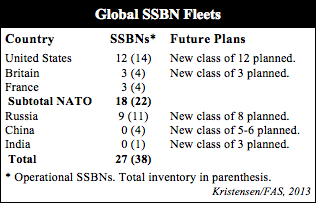 Finally, reducing the SSBN fleet to eight boats seems reasonable because no other country currently plans to operate more than eight SSBNs (see table). The United States today operates more SSBNs than any other country. And NATO’s three nuclear weapon states currently operate a total of 22 SSBNs, twice as many as Russia. China and India are also building SSBNs but they’re far less capable and not yet operational.
Finally, reducing the SSBN fleet to eight boats seems reasonable because no other country currently plans to operate more than eight SSBNs (see table). The United States today operates more SSBNs than any other country. And NATO’s three nuclear weapon states currently operate a total of 22 SSBNs, twice as many as Russia. China and India are also building SSBNs but they’re far less capable and not yet operational.
Conclusions and Recommendations
The Navy could and should reduce its SSBN fleet from 14 to eight boats as proposed by CBO. Doing so would shed excess capacity, help prepare the nuclear force level recommended by the new nuclear weapons employment policy, better match the force levels of other countries, and save billions of dollars. There are several reasons why this is possible:
First, the decision to go to 10 operational SSBNs in the 2030s suggests that the Navy is currently operating too many SSBNs and could immediately retire the two oldest Ohio-class SSBNs.
Second, the decision to build a new SSBN fleet with 144 fewer SLBM launch tubes than the current SSBN fleet is a blatant admission that the current force is significantly in excess of national security needs.
Third, the acknowledgement in November 2011 by former STRATCOM commander Gen. Robert Kehler that the reduction of 144 missile tubes “did not assume any specific changes to targeting or employment guidance” suggests there’s a significant over-capacity in the current SSBN fleet.
Fourth, it is highly unlikely that presidential nuclear guidance three decades from now – when the planned 12-boat SSBNX fleet becomes operational – will not have further reduced the nuclear arsenal and operational requirement significantly.
Fifth, reducing the SSBN fleet now would allow significant additional cost savings: $11 billion in 2015-2023 (and $30 billion more in the 2030s) from reduced ship building according to CBO; completing the W76-1 production earlier with 500 fewer warheads; $7 billion from reducing production of the life-extended Trident missile (D5LE) by 112 missiles; operational savings from retiring six Ohio-class SSBNs early; and by reducing the warhead production capacity requirement for the expensive Uranium Production Facility and Chemistry and Metallurgy Research facilities.
Sixth, reducing the SSBN fleet would help reduce the growing disparity between U.S. and Russian strategic missiles. This destabilizing trend keeps Russia in a worst-case planning mindset suspicious of U.S. intensions, drives large warhead loadings on each Russian missile, and wastes billions of dollars and rubles on maintaining larger-than-needed strategic nuclear force postures.
Change is always hard, but a reduction of the SSBN fleet would be a win for all.
This publication was made possible by grants from the New-Land Foundation and Ploughshares Fund. The statements made and views expressed are solely the responsibility of the author.
New START Data Shows Russia Reducing, US Increasing Nuclear Forces
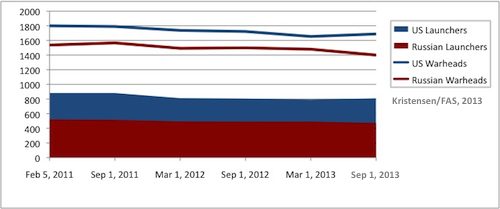
By Hans M. Kristensen
While arms control opponents in Congress have been busy criticizing the Obama administration’s proposal to reduce nuclear forces further, the latest data from the New START Treaty shows that Russia has reduced its deployed strategic nuclear forces while the United States has increased its force over the past six months.
Yes, you read that right. Over the past six months, the U.S. deployed strategic nuclear forces counted under the New START Treaty have increased by 34 warheads and 17 launchers.
It is the first time since the treaty entered into effect in February 2011 that the United States has been increasing its deployed forces during a six-month counting period.
We will have to wait a few months for the full aggregate data set to be declassified to see the details of what has happened. But it probably reflects fluctuations mainly in the number of missiles onboard ballistic missile submarines at the time of the count.
Slooow Implementation
The increase in counted deployed forces does not mean that the United States has begun to build up is nuclear forces; it’s an anomaly. But it helps illustrate how slow the U.S. implementation of the treaty has been so far.
Two and a half years into the New START Treaty, the United States has still not begun reducing its operational nuclear forces. Instead, it has worked on reducing so-called phantom weapons that have been retired from the nuclear mission but are still counted under the treaty.
For reasons that are unclear (but probably have to do with opposition in Congress), the administration has chosen to reduce its operational nuclear forces later rather than sooner. Not until 2015-2016 is the navy scheduled to reduce the number of missiles on its submarines. The air force still hasn’t been told where and when to reduce the ICBM force or which of its B-52 bombers will be denuclearized.
Moreover, even though the navy has already decided to reduce the missile tubes on its submarine force by more than 30 percent from 280 in 2016 to 192 on its next-generation ballistic missile submarine, it plans to continue to operate the larger force into the 2030s even though it is in excess of targeting and employment guidance.
Destabilizing Disparity
But even when the reductions finally get underway, the New START Treaty data illustrates an enduring problem: the growing disparity between U.S. and Russian strategic nuclear forces. The United States now is counted with 336 deployed nuclear launchers more than Russia.
Russia is already 227 deployed missiles and bombers below the 700 limit established by the treaty for 2018, and might well drop by another 40 by then to about 430 deployed strategic launchers. The United States plans to keep the full 700 launchers.
Put in another way: unless the United States significantly reduces its ICBM force beyond the 400 or so planned under the New START Treaty, and unless Russia significantly increases deployment of new missiles beyond what it is currently doing, the United States could end up having nearly as many launchers in the ICBM-leg of its Triad as Russia will have in its entire Triad.
Strange Bedfellows
For most people this might not matter much and even sound a little Cold War’ish. But for military planners who have to entertain potential worst-case threat scenarios, the growing missile-warhead disparity between the two countries is of increasing concern.
For the rest of us, it should be of concern too, because the disparity can complicate arms reductions and be used to justify retaining excessively large expensive nuclear force structures.
For the Russian military-industrial complex, the disparity is good for business. It helps them argue for budgets and missiles to keep up with the United States. But since Russia is retiring its old Soviet-era missiles and can’t build enough new missiles to keep some degree of parity with the United States, it instead maximizes the number of warheads it deploys on each new missile.
As a result, the Russian Strategic Rocket Forces has begun a program to deploy modified SS-27 ICBMs with multiple warheads (the modified SS-27 is known in Russia as RS-24 or Yars) with six missile divisions over the next decade and a half (more about that in a later blog). And a new “heavy” ICBM with up to ten warheads per missile is said to be under development.
So in a truly bizarre twist, U.S. lawmakers and others opposing additional nuclear reductions by the Obama administration could end up help providing the excuse for the very Russia nuclear modernization they warn against.
Granted, the Putin government may not be the easiest to deal with these days. But that only makes it more important to continue with initiatives that can take some of the wind out of the Russian military’s modernization plans. Slow implementation of the New START Treaty and retention of a large nuclear force structure certainly won’t help.
See also blog on previous New START data.
This publication was made possible by grants from the New-Land Foundation and Ploughshares Fund. The statements made and views expressed are solely the responsibility of the author.
MSNBC On Nuclear Weapons Reduction Efforts
By Hans M. Kristensen
MSNBC used FAS data on the world nuke arsenals in an interview with Ploughshares Fund president Joe Cirincione about how deteriorating US-Russian relations might affect efforts to reduce nuclear arsenals.
The updated weapons estimates on the FAS web site are here.
Detailed profiles of each nuclear weapon state are published as Nuclear Notebooks in the Bulletin of the Atomic Scientists.
Support our work to produce high-quality estimates of world nuclear forces: Donate here.
Air Force Intelligence Report Provides Snapshot of Nuclear Missiles
By Hans M. Kristensen
The U.S. Air Force National Air and Space Intelligence Center (NASIC) has published its long-awaited update to the Ballistic and Cruise Missile Threat report, one of the few remaining public (yet sanitized) U.S. intelligence assessment of the world nuclear (and other) forces.
Previous years’ reports have been reviewed and made available by FAS (here, here, and here), and the new update contains several important developments – and some surprises.
Most important to the immediate debate about further U.S.-Russian reductions of nuclear forces, the new report provides an almost direct rebuttal of recent allegations that Russia is violating the INF Treaty by developing an Intermediate-range ballistic missile: “Neither Russia nor the United States produce or retain any MRBM or IRBM systems because they are banned by the Intermediate-Range Nuclear Force Treaty, which entered into force in 1988.”
Another new development is a significant number of new conventional short-range ballistic missiles being deployed or developed by China.
Finally, several of the nuclear weapons systems listed in a recent U.S. Air Force Global Strike Command briefing are not included in the NASIC report at all. This casts doubt on the credibility of the AFGSC briefing and creates confusion about what the U.S. Intelligence Community has actually concluded.
Russia
The report estimates that Russia retains about 1,200 nuclear warheads deployed on ICBMs, slightly higher than our estimate of 1,050. That is probably a little high because it would imply that the SSBN force only carries about 220 warheads instead of the 440, or so, warheads we estimate are on the submarines.
“Most” of the ICBMs “are maintained on alert, capable of being launched within minutes of receiving a launch order,” the report states. This excessive alert posture is similar to that of the United States, which has essentially all of its ICBMs on alert.
The report also confirms that although Russia is developing and deploying new missiles, “the size of the Russia missile force is shrinking due to arms control limitations and resource constraints.”
Unfortunately, the report does not clear up the mystery of how many warheads the SS-27 Mod 2 (RS-24, Yars) missile carries. Initially we estimated thee because the throw-weight is similar to the U.S. Minuteman III ICBM. Then we considered six, but have recently settled on four, as the Strategic Rocket Forces commander has stated.
The report states that “Russia tested a new type of ICBM in 2012,” but it undercuts rumors that it not an ICBM by listing its range as 5,500+ kilometers. Moreover, in an almost direct rebuttal of recent allegations that Russia is violating the INF Treaty by developing an Intermediate-range ballistic missile, the report concludes: “Neither Russia nor the United States produce or retain any MRBM or IRBM systems because they are banned by the Intermediate-Range Nuclear Force Treaty, which entered into force in 1988.”
The report also describes how Russian designers are working to modify missiles to overcome U.S. ballistic missile defense systems. The SS-27 Mod 1 (Topol-M) deployed in silos at Tatishchevo was designed with countermeasures to ballistic missile systems, and Russian officials claim that a new class of hypersonic vehicle is being developed to overcome ballistic missile defense systems, according to NASIC.
The report also refers to Russian press report that a rail-mobile ICBM is being considered, and that a new “heavy” ICBM is under development.
One of the surprises in the report is that SS-N-32/Bulava-30 missile on the first Borei-class SSBN is not yet considered fully operational – at least not by NASIC. The report lists the missile as in development and “not yet deployed.”
Another interesting status is that while the AS-4 and AS-15 nuclear-capable air-launched cruise missiles are listed as operational, the new Kh-102 nuclear cruise missile that Russian officials have said they’re introducing is not listed at all. The Kh-102 was also listed as already “fielded” by a recent U.S. Air Force Global Strike Command briefing.
Finally, while the report lists the SS-N-21 sea-launched cruise missile as operational, it does not mention the new Kalibr cruise missile for the Yasen-class attack submarine that U.S. Air Force Global Strike Command recently listed a having been “fielded” within the past five years.
China
The NASIC report states that the Chinese ballistic missile force is expanding both in size and types of missiles.
Deployment of the DF-31A (CSS-10 Mod 2) ICBM continues at a slow pace with “more than 15” launchers deployed six years after the system was first introduced.
Despite many rumors about a new DF-41 ICBM, the NASIC report does not mention this system at all.
Deployment of the shorter-range DF-31 (CSS-10 Mod 1) ICBM, on the contrary, appears to have stalled or paused, with only 5-10 launchers deployed seven years after it was initially introduced (see my recent analysis of this trend here). Moreover, the range of the DF-31 is lowered a bit, from 7,200+ km in the 2009 report to 7,000+ in the new version.
Medium-range nuclear missiles include the DF-21 (CSS-5) (in two versions: Mod 1 and Mod 2, but with identical range etc.) and the old DF-3A (CSS-2), which is still listed as deployed. Only 5-10 launchers are left, probably in a single brigade that will probably convert to DF-21 in the near future.
An important new development concerns conventional missiles, where the NASIC report states that several new systems have been introduced or are in development. This includes a “number of new mobile, conventionally armed MRBMs,” apparently in addition to the DF-21C and DF-21D already known. As for the DF-21D anti-ship missile, report states that “China has likely started to deploy” the missile but that it is “unknown” how many are deployed.
More dramatic is the development on five new short-range ballistic missiles, including the CSS-9, CSS-11, CSS-14, CSS-X-15, and CSS-X-16. The CSS-9 and CSS-14 come in different versions with different ranges. The CSS-11 Mod 1 is a modification of the existing DF-11, but with a range of over 800 kilometers (500 miles). None of these systems are listed as nuclear-capable.
Concerning sea-based nuclear forces, the NASIC report echoes the DOD report by saying that the JL-2 SLBM for the new Jin-class SSBN is not yet operational. The JL-2 is designated as CSS-NX-14, which I thought it was a typo in the 2009 report, as opposed to the CSS-NX-3 for the JL-1 (which is also not operational).
NASIC concludes that JL-2 “will, for the first time, allow Chinese SSBNs to target portions of the United States from operating areas located near the Chinese coast.” That is true for Guam and Alaska, but not for Hawaii and the continental United States. Moreover, like the DF-31, the JL-2 range estimate is lowered from 7,200+ km in the 2009 report to 7,000+ km in the new version. Earlier intelligence estimates had the range as high as 8,000+ km.
One of the surprises (perhaps) in the new report is that it does not list the CJ-20 air-launched cruise missile, which was listed in the U.S. Air Force Global Strike Command briefing as a nuclear cruise missile that had been “fielded” within the past five years.
Concerning the overall size of the Chinese nuclear arsenal, there have been many rumors that it includes hundreds or even thousands of additional warheads more than the 250 we estimate. STRATCOM commander has also rejected these rumors. To that end, the NASIC report lists all Chinese nuclear missiles with one warhead each, despite widespread rumors in the news media and among some analysts that multiple warheads are deployed on some missiles.
Yet the report does echo a projection made by the annual DOD report, that “China may also be developing a new road-mobile ICBM capable of carrying a MIRV payload.” But NASIC does not confirm widespread news media rumors that this system is the DF-41 – in fact, the report doesn’t even mention the DF-41 as in development.
As for the future, the NASIC report repeats the often-heard prediction that “the number of warheads on Chinese ICBMs capable of threatening the United States is expected to grow to well over 100 in the next 15 years.” This projection has continued to slip and NASIC slips it a bit further into the future to 2028.
Pakistan
Most of the information about the Pakistani system pretty much fits what we have been reporting. The only real surprise is that the Shaheen-II MRBM does still not appear to be fully deployed, even though the system has been flight tested six times since 2010. The report states that “this missile system probably will soon be deployed.”
India
The information on India also fits pretty well with what we have been reporting. For example, the report refers to the Indian government saying the Agni II IRBM has finally been deployed. But NASIC only lists “fewer than 10” Agni II launchers deployed, the first time I have seen a specific reference to how many of this system are deployed. The Agni III IRBM is said to be ready for deployment, but not yet deployed.
North Korea
The NASIC report lists the Hwasong-13 (KN-08), North Korea’s new mobile ICBM, but confirms that the missile has not yet been flight tested. It also lists an IRBM, but without naming it the Musudan.
The mysterious KN-09 coastal-defense cruise missile that U.S. Air Force Global Strike Command recently listed as a new nuclear system expected within the next five years is not mentioned in the NASIC report.
Full NASIC report: Ballistic and Cruise Missile Threat 2013
See also previous NASIC reports: 2009 | 2006 | 1998
This publication was made possible by grants from the New-Land Foundation and Ploughshares Fund. The statements made and views expressed are solely the responsibility of the author.
